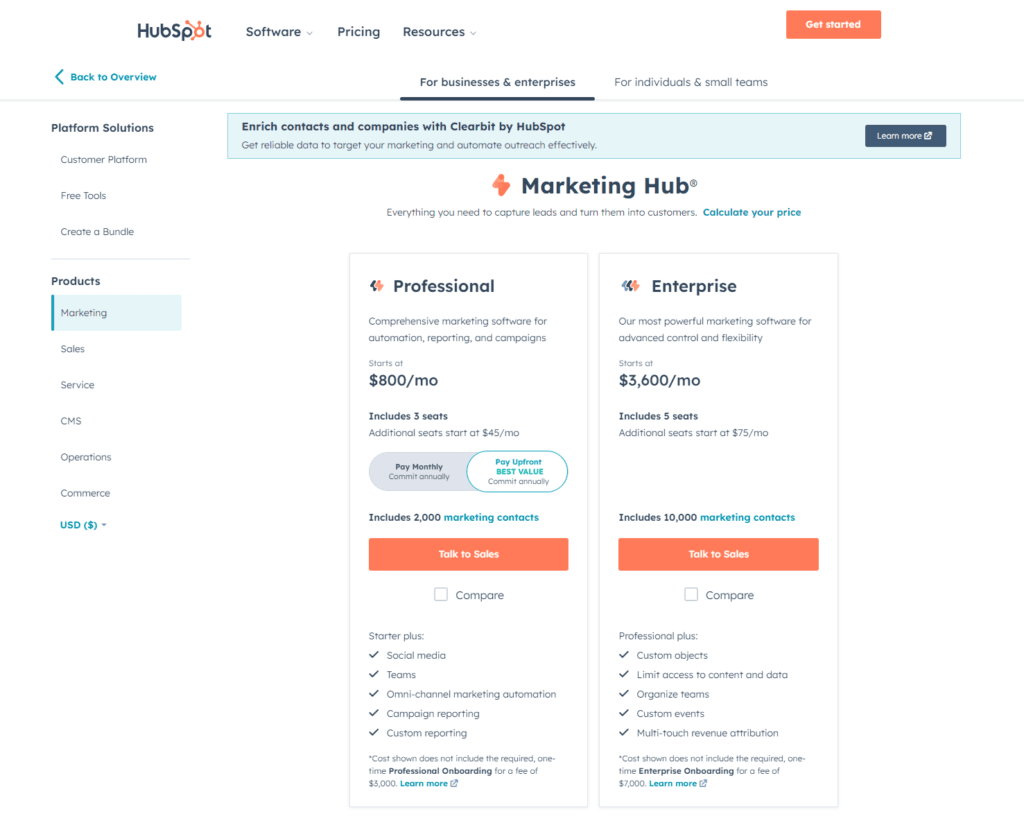In the bustling marketplace of digital tools, picking the right analytics platform can feel like searching for a needle in a haystack. But fear not, because today we’re slicing through the noise to compare two giants in the analytics world: Oracle Analytics Cloud (OAC) and HubSpot Marketing Analytics. Whether you’re a data-driven marketer, a business analyst looking to make sense of consumer trends, or an entrepreneur eager to get your hands on the most insightful tools, this showdown is for you. We’re here to unpack the features, dive deep into the nitty-gritty, and ultimately help you decide which tool is the crown jewel for your business analytics needs. So, grab a cup of coffee, and let’s get analytical in the most user-friendly way possible!
| Oracle Analytics Cloud | HubSpot Marketing Analytics |
|---|---|
 |  |
| G2 Score -4.0 out of 5 | G2 Score -4.4 out of 5 |
| TrustRadius Score -8.1 out of 10 | TrustRadius Score -8.5 out of 10 |
Oracle Analytics Cloud vs HubSpot Marketing Analytics: Ease of Use and User Interface
One of the most critical factors in choosing an analytics tool is how easy it is to use. After all, what good is a tool if it requires a Ph.D. to understand? In today’s comparison, we’ll start by looking at the ease of use and user interface of Oracle Analytics Cloud and HubSpot Marketing Analytics.
Oracle Analytics Cloud: Navigating the Depths
Oracle Analytics Cloud is a beast in the analytics realm, designed to serve up deep insights across all levels of an organization. With its comprehensive capabilities, it offers a wide range of analytics services from data visualization to advanced analytics and everything in between. But with great power comes great complexity.
The user interface of OAC is robust and detailed, aimed at providing users with a wide array of analytics tools at their fingertips. While it’s a dream come true for data analysts and those comfortable navigating complex platforms, it can be a bit overwhelming for beginners or small business owners looking for quick insights.
Oracle has made efforts to streamline the user experience with customizable dashboards and drag-and-drop features in its data visualization tools, making it more accessible to users who aren’t data wizards. However, the sheer breadth of options and settings can pose a steep learning curve for newcomers.
HubSpot Marketing Analytics: User-Friendly from the Get-Go
HubSpot, known for its all-in-one marketing platform, extends its user-friendly ethos to its Marketing Analytics tools as well. Designed with marketers in mind, HubSpot’s analytics are intuitive and straightforward, making it easy for users of all skill levels to dive into data analysis without getting bogged down by overly technical details.
The platform shines in its ability to present complex data in an easily digestible format. Dashboards and reports are simple to customize, with clear, actionable insights that marketers can use to adjust their strategies on the fly. For small to medium-sized businesses, or those with a keen focus on inbound marketing, HubSpot Marketing Analytics feels like a natural extension of the marketing workflow rather than a separate, daunting tool to master.
HubSpot’s approach to analytics prioritizes the user experience, making it an attractive option for those who value time and simplicity. The platform provides a gentle learning curve, supported by a plethora of educational resources and a supportive community forum, ensuring users can maximize the value of their analytics with minimal frustration.
Oracle Analytics Cloud vs HubSpot Marketing Analytics: Decoding Pricing
Pricing structures in the world of digital analytics tools can be as complex as the data they help analyze. Both Oracle Analytics Cloud and HubSpot Marketing Analytics have nuanced pricing models that cater to different scales and types of users. Let’s unwrap these models to see which might fit your budget and business needs better.
Oracle Analytics Cloud: Enterprise-Grade Investment

Oracle Analytics Cloud is tailored for enterprise use, and its pricing model reflects this. OAC offers a tiered pricing structure based on the services you require and the volume of data processed. This can include data storage, computing resources, and access to advanced analytics features. The model is primarily subscription-based, with the cost scaling according to the breadth of services and the level of usage.
While specific pricing details can vary and often require direct consultation with Oracle for a customized quote, businesses should be prepared for a significant investment when adopting OAC. This investment, however, comes with the promise of a comprehensive, robust analytics solution capable of serving a wide range of enterprise-level needs, from data integration and management to advanced analytics.
For organizations with the budget and the requirement for a powerful, scalable analytics platform, OAC can be a fitting choice. The initial investment might be high, but for enterprises looking to leverage data across multiple dimensions, the return on investment can be substantial.
HubSpot Marketing Analytics: Scalable Pricing for Growing Businesses

HubSpot takes a more accessible approach to pricing, particularly appealing to small and medium-sized businesses or marketing teams within larger organizations. The HubSpot Marketing Hub, which includes marketing analytics along with a suite of other marketing tools, offers several pricing tiers, starting from a free option with basic features, to more advanced tiers that include additional marketing tools and analytics capabilities.
The pricing tiers for the HubSpot Marketing Hub are designed to grow with your business, starting from a free entry-level option to more comprehensive packages that cater to more advanced needs. This scalability ensures that businesses can start small and upgrade as their marketing and analytics requirements evolve.
Moreover, HubSpot’s pricing is transparent, with details readily available on their website. This transparency helps businesses plan their investments and understand exactly what features and capabilities they’re getting at each pricing tier.
Customer support
Exploring the terrain of customer support can often be as enlightening as examining the technical features of a tool. The quality of support provided by a platform can significantly impact the user experience, especially when navigating complex analytics landscapes. Let’s delve into how Oracle Analytics Cloud (OAC) and HubSpot Marketing Analytics approach customer support, ensuring users not only have access to powerful analytics capabilities but also the guidance needed to utilize these tools effectively.
Oracle Analytics Cloud: Comprehensive Support for Complex Needs
Oracle Analytics Cloud caters to enterprises with sophisticated data analytics requirements, and its approach to customer support is designed to match this complexity. Users have access to a comprehensive support system that includes: Oracle offers round-the-clock support for critical issues, ensuring that businesses operating across different time zones can receive help whenever needed.
For enterprise clients, OAC often provides dedicated account managers who serve as the point of contact for all support-related queries. This personalized approach ensures that issues are resolved efficiently, with an understanding of the specific needs and configurations of the business. Oracle has a rich repository of documentation, tutorials, and user forums. This resource pool enables users to self-serve many of their queries and learn from the broader Oracle community.
OAC supports its users with detailed training sessions and certification programs, designed to help teams maximize the utility of the platform. While this is a form of indirect support, it plays a crucial role in enabling users to effectively leverage the analytics capabilities of OAC.
HubSpot Marketing Analytics: User-Friendly Support for Marketing Teams
HubSpot Marketing Analytics, known for its user-friendly approach, extends this philosophy to its customer support as well. The platform offers a variety of support channels tailored to meet the needs of its diverse user base, from small businesses to larger enterprises: HubSpot provides an extensive online resource center that covers a wide range of topics, from basic setup queries to advanced analytics techniques. This self-help option is designed to quickly answer common questions and facilitate easy learning.
The HubSpot Community is an active forum where users can ask questions, share insights, and learn from each other’s experiences. This peer-to-peer support mechanism is invaluable for solving common issues and learning best practices. For more direct assistance, HubSpot offers email and phone support, with the level of access depending on the user’s subscription tier. Premium tiers enjoy more direct and immediate access to support teams.
HubSpot Academy is a treasure trove of training materials, courses, and certifications that empower users to better understand and utilize the platform’s capabilities. Like OAC, these educational resources serve as a form of support, enhancing the user’s ability to effectively engage with the tool.

Related: Check out our free SEO suite

Oracle Analytics Cloud vs HubSpot Marketing Analytics: Integration and Ecosystem
In the digital age, where tools and platforms are as interconnected as the people using them, an analytics tool’s ability to play nice with others is crucial. Let’s talk about how Oracle Analytics Cloud (OAC) and HubSpot Marketing Analytics stack up when it comes to integration capabilities and ecosystem compatibility.
Oracle Analytics Cloud: The Universal Adapter
Think of Oracle Analytics Cloud as the Swiss Army knife in your digital toolbox. It’s designed to integrate seamlessly with a vast array of data sources, both Oracle and non-Oracle, including cloud-based services, on-premises databases, and even flat files like CSVs. This flexibility makes OAC a powerhouse for organizations that pull data from a diverse set of sources to drive their analytics.
Moreover, OAC’s robust API capabilities allow for extensive customization and automation, offering businesses the flexibility to tailor the platform to their unique needs. Whether you’re looking to enhance your data workflows with AI-driven insights or automate your reporting processes, OAC provides the building blocks to do so.
However, the breadth of OAC’s integration capabilities can be as much a challenge as it is an advantage. The setup and maintenance of these integrations require a certain level of technical know-how, making it more suited for organizations with IT resources dedicated to managing their analytics ecosystem.
HubSpot Marketing Analytics: The Marketing Maestro
On the other side of the ring, we have HubSpot Marketing Analytics, which, true to HubSpot’s all-in-one marketing philosophy, offers deep integration within its own ecosystem. If your business is already a part of the HubSpot universe, using its Marketing Analytics feels like a breeze. Data from your CRM, email campaigns, social media activities, and website interactions are all automatically synced, providing a holistic view of your marketing efforts without the need for manual data wrangling.
HubSpot also plays well with others, offering integrations with popular tools like Salesforce, WordPress, and social media platforms, ensuring you can keep using your favorite tools while benefiting from HubSpot’s analytics. These integrations are generally user-friendly, emphasizing ease of use and minimizing the technical barriers to entry.
While HubSpot’s integration ecosystem is impressive, especially for marketing-centric organizations, it may not offer the same level of depth and flexibility in data sources and customization as OAC. The focus here is on providing a seamless, integrated marketing analytics experience that caters to the needs of marketers first and foremost.
Conclusion
As we conclude our exploration into Oracle Analytics Cloud (OAC) and HubSpot Marketing Analytics, it’s evident that the landscape of analytics tools is rich and varied, offering powerful options tailored to different business needs and goals. Our journey through the user interfaces, integration capabilities, and pricing models of these platforms highlights the importance of choosing an analytics tool that not only meets your current needs but also aligns with your future growth trajectory.
READ NEXT:
- Oracle Analytics Cloud vs Zoho Analytics: The Best Analytics Tool for You
- Oracle Analytics Cloud vs Amplitude: The Best Analytics Tool for You
- MicroStrategy vs Tableau: The Best Analytics Tool for You
- MicroStrategy vs Amplitude: The Best Analytics Tool for You
- Oracle Analytics Cloud vs Statcounter: The Best Analytics Tool for You
- 11 Marketing Analytics Tools to Elevate Your Data-Driven Strategies
- 29+ Digital Analytics Software to Skyrocket Your Digital ROI






















Comments are closed.